How to Build a DeFi Full-Stack Protocol with Stablecoins at its Core
Conclusion
$Frax Finance is a full-stack DeFi protocol centered around decentralized stablecoins, spanning across Real World Assets (RWA), lending, and Liquid Staking Derivatives (LSD) sectors. In 2024, it established its own Layer2, and increased its stablecoin collateral ratio to 100% full collateralization. The protocol aims to integrate the $FRAX stablecoin throughout the entire ecosystem, and extend its influence across all DeFi sectors. From a business potential perspective, the growth in RWA business supports protocol liquidity during bear markets, while the AMO plays its most significant role in bull markets. Layer2 is a key factor in elevating the overall project valuation ceiling of Frax.
Holy Grail
Decentralized stablecoins face a trilemma involving capital efficiency, decentralization, and price stability, constantly seeking a balance among these aspects has become a desirable yet elusive goal.
USDT and USDC excel in capital utilization efficiency and price stability, which has enabled them to create significant market value and application scenarios. However, they are highly centralized in terms of decentralization.
DAI, as the decentralized stablecoin with the longest history, initially excelled in decentralization, primarily using ETH as collateral for over-collateralized stablecoin minting. Although the high collateralization ratio ensured price stability, it sacrificed capital efficiency. As a result, in terms of application scenarios and market capitalization, it was far behind centralized stablecoins. Later, DAI gradually accepted centralized assets as collateral, sacrificing some degree of decentralization for a gradually increasing market capitalization.
UST is the most controversial decentralized stablecoin, achieving the pinnacle of capital utilization efficiency while also possessing decentralized characteristics. It once created a market value scale second only to USDT and USDC. However, its aggressive strategy led to a 'death spiral' in the stablecoin's price under extreme conditions.
Thus, up to this day, a "perfect" decentralized stablecoin has yet to emerge, which might be the "Holy Grail" that builders continue to pursue relentlessly.

Background Analysis
$Frax Finance is a full-stack protocol centered around decentralized stablecoins. Starting as a partially collateralized algorithmic stablecoin, it has gradually transitioned to full collateralization while maximizing capital utilization. Additionally, it has expanded horizontally into multiple areas, ultimately creating a matrix-like full-stack DeFi protocol driven by stablecoins. It is also the longest-surviving non-fully collateralized stablecoin.
Its products include:
$FRAX stablecoin: A decentralized US dollar stablecoin
FPI: A stablecoin pegged to a basket of goods to hedge against inflation
frxETH: LSD
Fraxlend: Lending
Fraxswap: A Time-Weighted Decentralized Exchange
Fraxferry: Cross-chain Transfer
FXS & veFXS: Governance Module
AMO: Algorithmic Market Operations Controller
$Frax Bond - Bonds
RWA - Real World Assets
$Frax Chain - Layer2
Since its launch, $Frax has gone through three versions: v1, v2, and v3. Unlike many protocols in the market, each version of $Frax is not just an upgrade in functionality. Each iteration also comes with significant strategic shifts. This means if you missed out on any version, your understanding of $Frax could be entirely different.
$Frax v1: It was launched with the goal of becoming an algorithmic stablecoin, utilizing a "fractional algorithm" to gradually reduce the collateral ratio, thereby maximizing capital efficiency.
$Frax v2: Strategically abandoning the approach of gradually reducing the collateralization ratio of algorithmic stablecoins, and shifting towards increasing the collateralization ratio to become fully collateralized. Developing AMO to enter the Curve war, competing for on-chain liquidity governance resources, and developing frxETH to venture into the Ethereum liquidity staking race LSD.
$Frax v3: Introduces Real World Assets (RWA) and continues to leverage AMO for liquidity across both on-chain and off-chain environments.
Business Analysis
This article will start with the upcoming version v3 of $Frax, and proceed to analyze and comb through the full stack of $Frax products one by one, taking you through the entirety of $Frax Finance.
$Frax Finance v3
$Frax v3 is an upcoming version that will focus on Real World Assets (RWA) while continuing to utilize the AMO from v2 to gradually transform $FRAX into a fully exogenous collateralized, multi-dimensional decentralized stablecoin that captures both on-chain and off-chain assets. Its core business features include:
Fully Exogenous Mortgage
RWA
IORB Oracle
frxGov governance module
FraxBond (FXB) Bonds
✹ Fully Exogenous Collateral
According toFRAX Balance Sheet(October 2023), the current version of $FRAX's Collateral Ratio (CR) is 91.85%.
CR = (Owned assets+Lent assets) / Liabilities
CR = (615,357,001+65,654,459) / 741,400,658 = 91.85%
📊 As of March 2024, $FRAX's balance sheet shows that the Collateral Ratio (CR) has reached 100%, primarily due to the rise in tokens such as $CRV, $CVX, and the accumulation of income.
Starting from the $Frax v3 version, the protocol will introduce Real World Assets (RWA) to enhance the Collateralization Ratio (CR) until the CR is >=100%, ultimately achieving 100% exogenous collateral for FRAX. In fact, in February 2023, the community proposal FIP188 halted the process of the $FRAX algorithmic stablecoin and began utilizing AMO.With the gradual increase in protocol revenue, the collateralization ratio (CR) improves:
FIP188The proposal is of symbolic significance to Frax. Starting from FIP188, $Frax will completely cease the "fractional algorithm" and "de-collateralization" functions, transitioning from a partially collateralized algorithmic stablecoin to being fully collateralized. Here are some key points of the proposal:
The initial version of $Frax included a "fractional algorithm," which is a variable collateral ratio that adjusts based on the market demand for FRAX. This effectively allows the market to determine the combination of external collateral and FXS needed for each $FRAX to be equivalent to 1.00 USD.
The reason for discontinuing the "score algorithm" is that, from a market perspective, the cost of slightly insufficient collateral far exceeds the benefits it brings. The market's concern over a 1% shortfall in collateral is much greater than the demand for an additional 10% in profits.
Over time, growth, asset appreciation, and protocol earnings will increase the Collateral Ratio (CR) to 100%. It should be clarified that this proposal does not rely on minting additional FXS to achieve a 100% CR.
Retain protocol revenue to provide funds for improving CR, temporarily suspend FXS buyback.
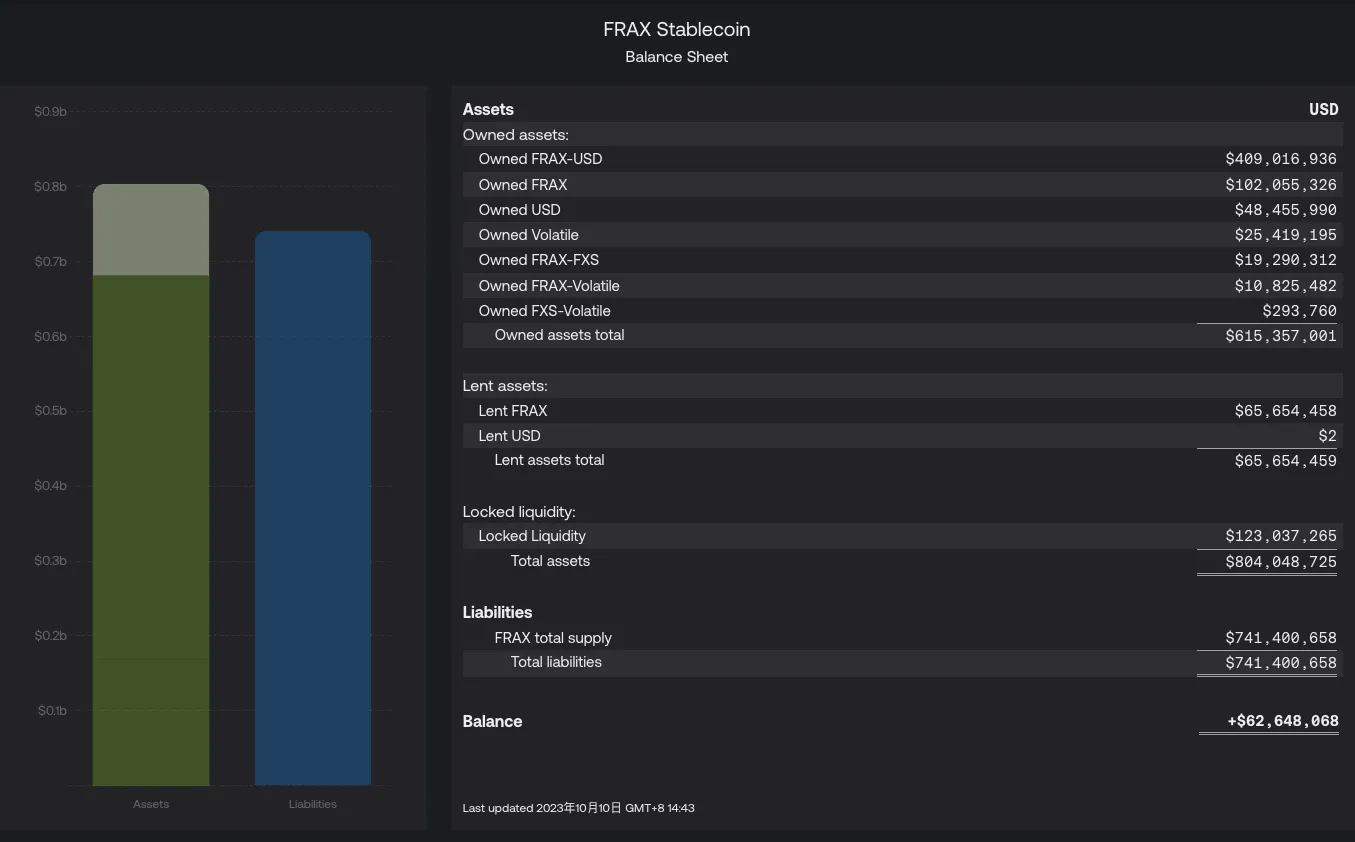
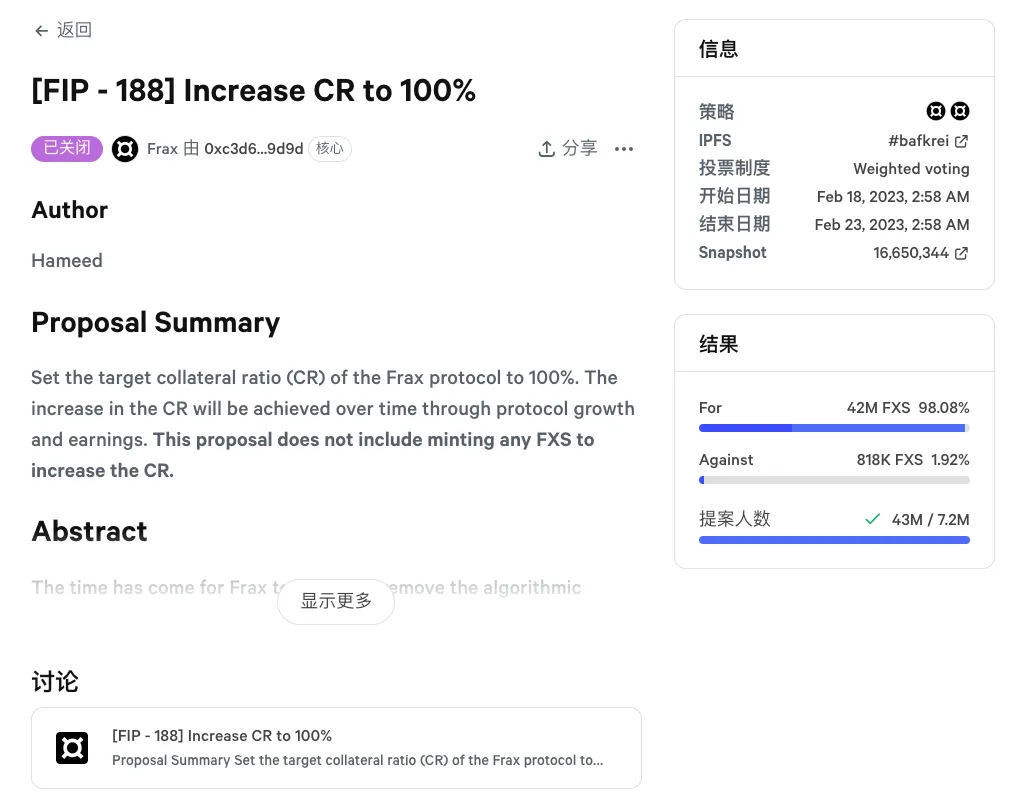
✹ RWA
As a key measure in $Frax v3 to elevate the Collateralization Ratio (CR) to or above 100%, the upcoming frxGov governance module in $Frax will authorize real-world entities to purchase and hold real assets, such as U.S. Treasury bonds, through AMO control.
Users holding $FRAX can deposit it into a designated smart contract and receive sFRAX in return. This principle is similar to the relationship between DAI and sDAI. Let's compare the differences between sFRAX and sDAI:
One reason sDAI can achieve slightly higher returns than the average government bond yield (currently at 5%, with a peak at 8%) is that not all DAI holders deposit their DAI into the DSR contract. The returns from Maker's investments in Real World Assets (RWA) only need to be distributed among those who have deposited DAI into DSR to obtain sDAI. Thus, effectively, a portion of the participants are sharing all the RWA returns.
sFRAX also meets this criterion, but $Frax, having accumulated a significant amount of Curve and Convex tokens during its version 2 phase, has locked these tokens to gain substantial voting power. This enables it to control certain $CRV and $CVX rewards on the blockchain, enhancing the overall returns of sFRAX. Additionally, it can swiftly switch between on-chain and off-chain operations if the returns diminish or the risks increase on one side.
✹ IORB Oracle
The $FRAX v3 smart contract adoptsInterest on Reserve Balances (IORB) at the Federal Reserve
Providing data for certain protocol functions, such as the staking rewards of sFRAX.
When the IORB rate increases, the $Frax protocol's AMO strategy will use treasury bills, reverse repurchase agreements, and dollars deposited at the Federal Reserve Bank paying IORB interest to heavily collateralize FRAX.
When the IORB interest rate decreases, the AMO strategy will begin to rebalance $FRAX collateral using on-chain decentralized assets and collateralized loans in Fraxlend.
In simple terms, $FRAX v3 adjusts its investment strategy based on the Federal Reserve's Interest on Reserve Balances (IORB). When off-chain yields are high, it allocates funds to treasury bills, government bonds, etc. Conversely, when on-chain yields are high, it directs funds to on-chain lending, such as Fraxlend, to ensure maximum returns and the stability of the stablecoin.
✹ frxGov Governance Module
$Frax v3 will remove multisig and fully implement governance through the smart contract frxGov module (veFXS). This is an important step towards decentralized governance for Frax.
✹ FraxBond (FXB) Bonds
sFRAX and FXB both introduce treasury yields into $Frax, but they differ in the following ways:
sFRAX serves as the zero-duration part of the yield curve, while FXB represents the forward part. Together, they form a comprehensive on-chain stablecoin yield curve.
If 50M $FRAX is staked as sFRAX, then an equivalent amount of ~50M USDC (assuming a Collateral Ratio (CR) of 100%) can be sent off-chain to purchase short-term government bonds worth 50M.
If 100M of 1-year FXB is sold for 95M USDC, it means that the off-chain collaborating entity can purchase 1-year treasury bonds with 95M USD.
Additionally, FXB is a transferable ERC-20 token that can build its own liquidity in the secondary market and circulate freely. It offers users stablecoin investment options with various terms, yield rates, and risk levels. It also provides new components for constructing new Lego combinations.
$Frax Finance v1
$Frax v1 introduced the concept of fractional-algorithmic stablecoins, which simply put, means that part of its supply is backed by exogenous collateral (USDC), while a portion is unsupported (using endogenous collateral FXS supported through algorithms).
For instance, with a Collateral Ratio (CR) of 85%, each redeemed $FRAX will yield the user $0.85 in USDC and $0.15 worth of FXS.

In version 1, AMO existed in its simplest form, known as the Score Algorithm. Its primary function was to regulate the Collateral Ratio (CR) for minting $FRAX based on market conditions. Initially, it was set to adjust at a fixed interval, such as every hour.
When $Frax v1 was first launched, it operated with a Collateralization Ratio (CR) of 100%, meaning 1 $FRAX was equivalent to 1 USDC. This period is referred to as the "Integer Phase." Subsequently, at regular intervals, the AMO would adjust the CR based on market conditions, either decreasing or increasing it, to transition into the "Fractional Phase."
If $FRAX is greater than 1, above its peg, and needs to expand, the Collateral Ratio (CR) will decrease, allowing more $FRAX to be minted with less collateral.
If the price of $FRAX falls below 1, the Collateral Ratio (CR) will increase, thereby increasing the collateral backing each $FRAX to restore confidence in the system.
Although the fractional algorithm can intervene in the CR when new $FRAX is minted, this method of influencing the overall system CR is relatively slow. In addition to this, $Frax v1 has introduced two more features to promote dynamic changes in CR, in order to align with the fractional algorithm and achieve the precise state of CR required by the protocol:
DecollateralizationAnd Recollateralization
Re-mortgaging: When the scoring algorithm increases the system's mortgage rate, in order to make the actual mortgage rate equal to the system's mortgage rate, the amount of USDC in the system must be increased. $FRAX has set up an incentive measure: anyone can add USDC to the system and exchange it for a larger amount of FXS; for example, a user can add 1 US dollar worth of USDC to the system and exchange it for 1.2 US dollars worth of FXS.
Redemption (Buyback): When the system's collateralization ratio is lowered, users can exchange FXS for an equivalent value of USDC from the system at any time, after which the FXS will be destroyed. There are no reward measures in the buyback mechanism.
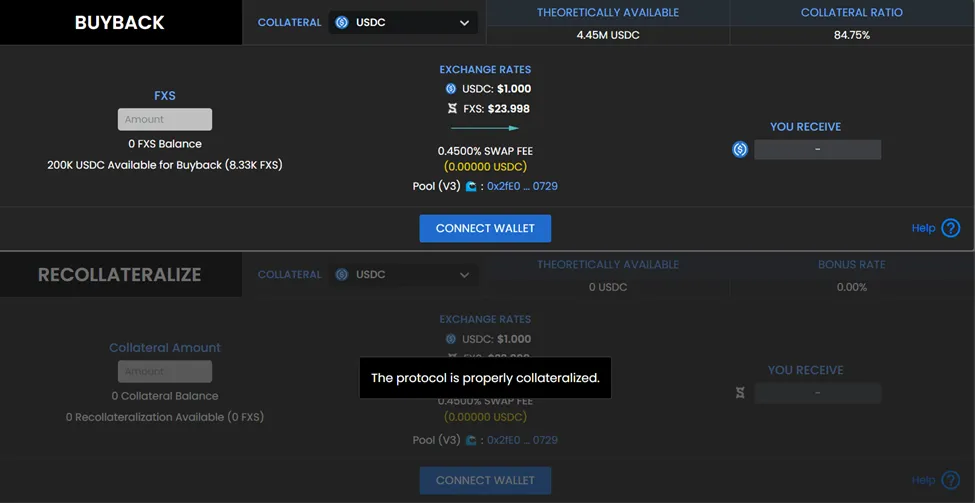
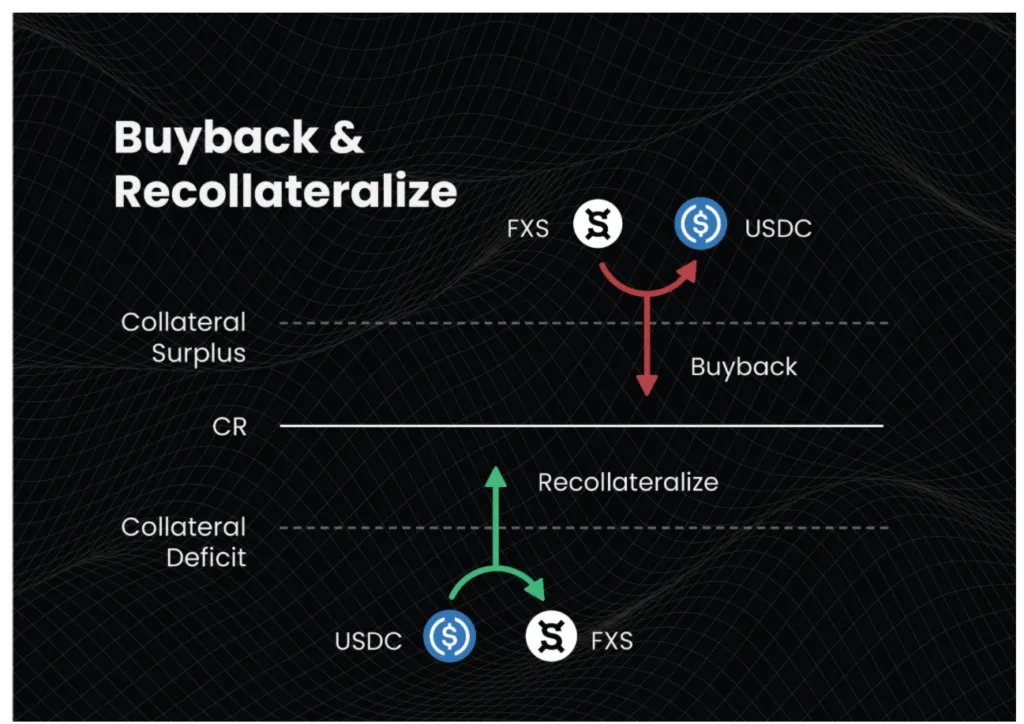
When $Frax v1 was launched, it coincided with a DeFi market dominated by algorithmic stablecoin projects. At the same time, other algorithmic stablecoin projects like Basis Cash and Empty Set Dollar (ESD) were also launched. Given the market trends at that time, $Frax was the most conservative among these algorithmic stablecoin projects. However, as the market frenzy subsided, $Frax was the only one that survived. Moreover, in the subsequent $Frax v2 version, it made a significant turnaround by adding collateral ratios and utilizing treasury funds.
$Frax Finance v2
$Frax v2 is the most actively updated version, which discontinued the fractional algorithm and introduced AMO for treasury fund management. It aims to gradually fill the Collateral Ratio (CR) with profits. Additionally, it launched new services like Fraxlend and frxETH, and became a winner in the Curve war by participating in the governance of on-chain liquidity.
In version 2, its core business includes:
AMO
Fraxlend
Fraxswap
FPI ($Frax Price Index)
frxETH
✹ AMO (Algorithmic Market Operations Controller)
AMO is a monetary policy tool similar to the Federal Reserve. Its mechanism operates on the principle that as long as it does not lower the collateral ratio and change the $FRAX price, it can set any $FRAX monetary policy. Within the confines of the established strategy algorithm, it can print money, destroy it, or reallocate funds. This means that the AMO controller can conduct open market operations through algorithms (hence their name), but they cannot simply mint $FRAX out of thin air to break the peg.
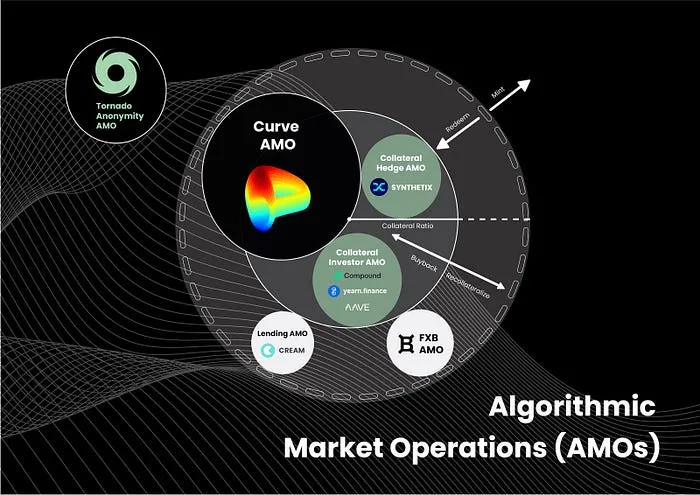
Currently, $Frax operates 4 AMOs, with the Curve AMO having the largest amount of funds. Along with the operation of AMOs, the protocol will utilize idle assets in the treasury (primarily USDC), combined with a certain amount of minting (algorithmically controlled $FRAX), to deploy into other DeFi protocols:
Maximizing the use of treasury funds to earn additional income. For example, if the treasury holds 1M USDC, and AMO prints 1M $FRAX, they can form a USDC-FRAX LP to mine, effectively earning mining profits on a 2M capital volume.
Since the ownership of the printed money (algorithm-controlled $FRAX) in AMO is held by the protocol and can be withdrawn and destroyed within the AMO strategy without circulating to users, it does not significantly impact $FRAX's pegging.
Without actually adding new collateral, the market value of $FRAX was increased.
Taking the Curve AMO strategy as an example for interpretation:
Decollateralize - Placing idle collateral and newly minted $FRAX from AMO into the Curve Pool.
Recollateralization involves initially withdrawing FRAX-USDC LP from the pool, destroying the excess $FRAX that was previously minted and controlled by the protocol, and returning USDC to increase the Collateral Ratio (CR).
Protocol Earnings - Accumulated transaction fees, $CRV rewards, and periodic rebalancing of the liquidity pool. Deposit LP tokens into platforms such as Yearn, Stake DAO, and Convex Finance to earn additional returns.
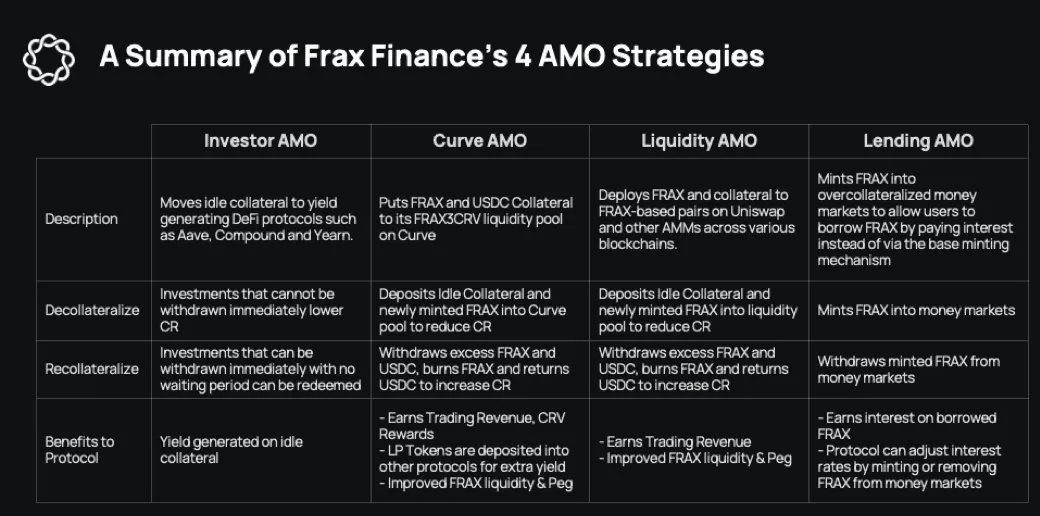
Let's analyze the crucial "money printing" capability of AMO.
The core of the "AMO" money-printing strategy can be summarized as:
When AMO plans to add USDC funds from the treasury to the Curve Pool, adding a large amount of USDC individually would affect the proportion of USDC in the pool, thereby impacting the price. Therefore, by 'minting' a corresponding amount of $FRAX to pair with USDC to form an LP, the funds can be added to the pool with minimal slippage. The LP is held and controlled by AMO.
In addition, if one wants to maximize "printing money," there's another scenario:
Let's assume a scenario where a pre-"printing" $FRAX supply is denoted as Y, and the market's tolerance for a $FRAX price drop below 1 USD is X%.
If selling all of Y at once into a Curve Pool with Z TVL and an A amplification factor results in less than X% impact on $FRAX's price, it demonstrates that the additional 'printing' of Y amount of $FRAX circulating in the open market is acceptable.
In other words, because the Curve AMO can compose $FRAX+USDC into LP and place it in its own Curve Pool to control the TVL, when $FRAX falls by X%, it can withdraw and destroy the excess $FRAX through the AMO Recollateralize operation to enhance the Collateral Ratio (CR) and bring the price back to its peg. The more LP controlled by the AMO, the stronger this capability.
Therefore, before $FRAX falls by X%, based on the AMO's ability to control LP, a quantity of $FRAX can be calculated. This quantity is allowed to be sold into the Curve Pool in one go without causing sufficient impact on the price to move the CR. This quantity represents the maximization of "minting".
For instance, a 3.3 billion TVL in the FRAX3Pool can support at least a $39.2 million $FRAX sell order without the price fluctuating more than 1 cent. If X equals 1%, then it's possible to achieve a "maximum minting" of at least 39.2 million algorithmic $FRAX on the open market.
The strategy mentioned above is an extremely powerful market maneuver that mathematically establishes a circulating lower bound for the algorithmic $FRAX without any risk of breaking its peg.
✹ Fraxlend
Fraxlend is a lending platform that offers a lending market between ERC-20 assets. Unlike the mixed lending pools of Aave v2, in Fraxlend, each lending pair is an isolated market. When you choose to deposit a certain collateral for borrowers to take loans against, it signifies your full recognition and acceptance of the value and risks associated with that collateral. Additionally, this design of isolated pools has two distinctive features:
Any issues related to collateral or non-performing loans are confined to the individual pairings and do not affect other lending pools;
The collateral cannot be lent out.
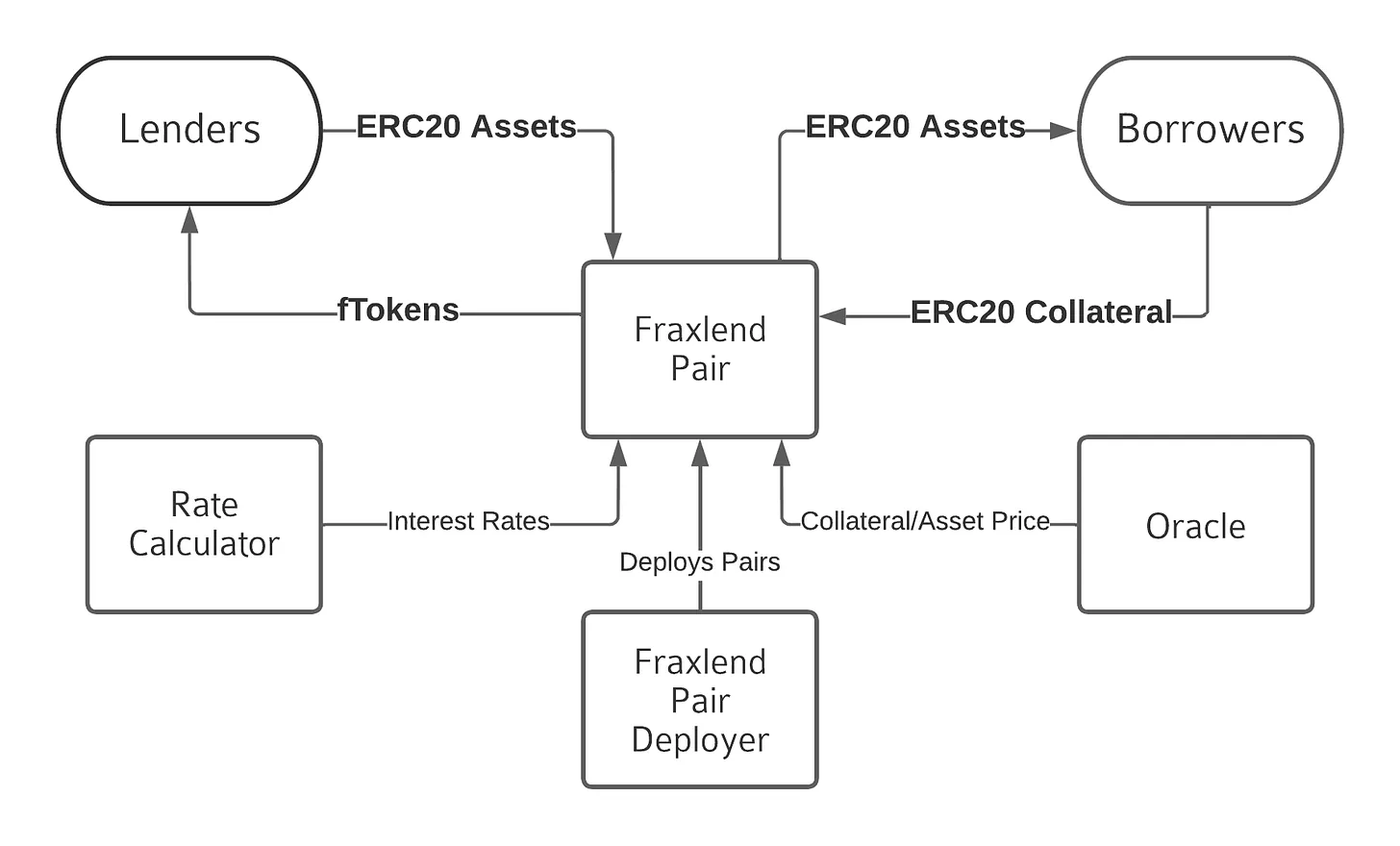
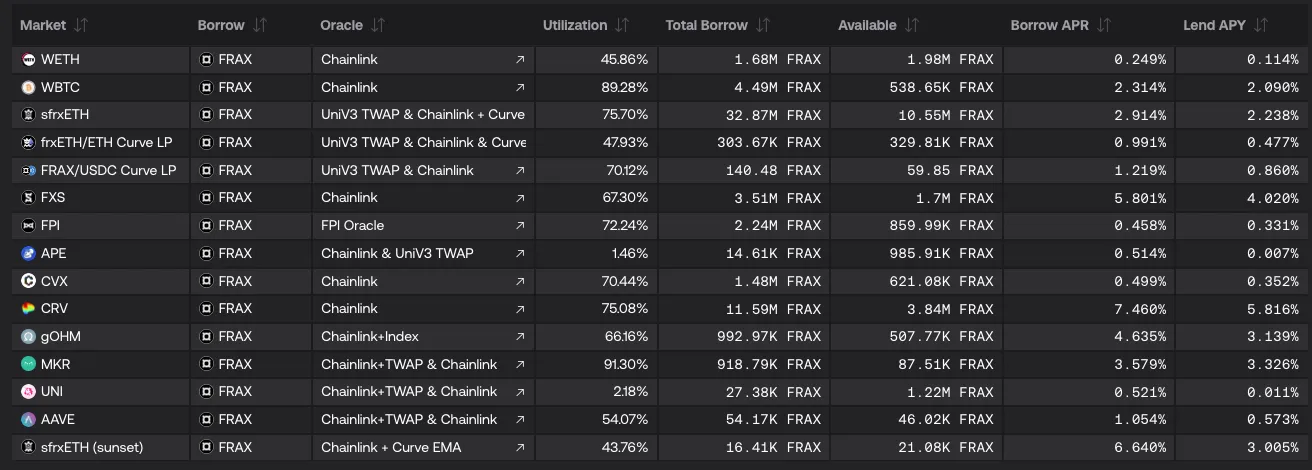
1/ Fraxlend Mechanism Features - Interest Rate Model
Fraxlend offers three interest rate models (in practice, models 2 and 3 are used).
Linear interest rate
Time-weighted floating interest rate
Floating Interest Rate V2
Unlike most lending agreements, all of Fraxlend's interest rate calculators automatically adjust based on market dynamics, without the need for governance intervention. The $Frax team believes that allowing the market to determine interest rates is better than having the team propose governance changes with every market fluctuation (as this method is slower).
Linear interest rateWhen the utilization rate of funds exceeds the critical value of the peak utilization rate, the interest rate curve begins to steepen. Most lending agreements adopt this basic interest rate growth model to ensure that when too much money is borrowed from the pool, raising interest rates encourages lenders to deposit and borrowers to repay.
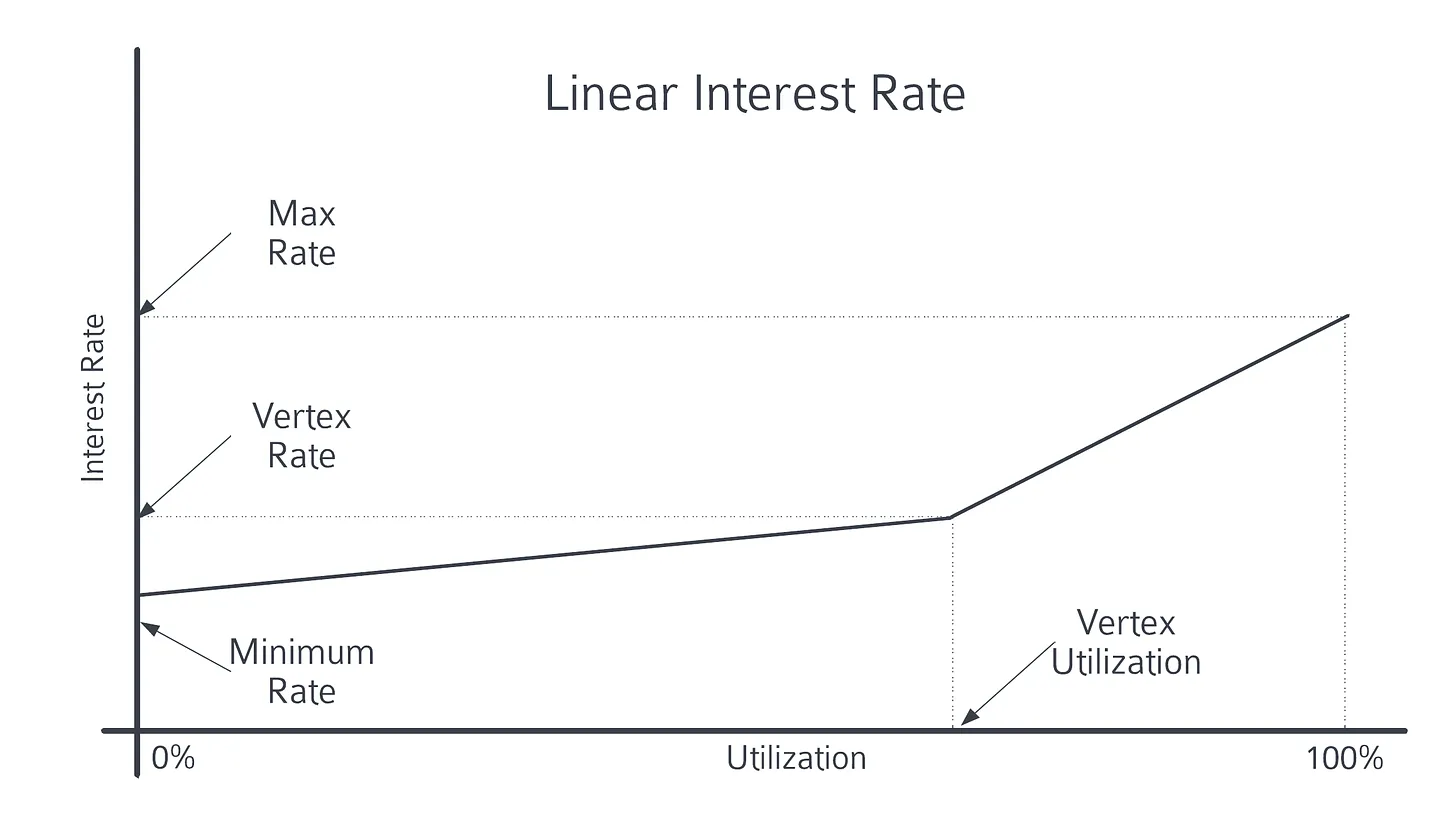
Time-weighted floating interest rate
Time-weighted floating interest rates adjust the current interest rate over time. It is controlled by three parameters:
Utilization Rate: Adjust interest rates based on the capital utilization rate.
Half-life: This value determines the speed of interest rate adjustments. In layman's terms, when the utilization rate is high, the interest rate will increase by a multiplier, and when the utilization rate is low, it will decrease.
Target Utilization Range: Within this range, interest rates will not be adjusted, as it is considered to be in line with market expectations.
In the available interest rate calculators, the half-life of the interest rate is 12 hours. If the utilization rate is 0%, the interest rate is halved, decreasing by 50% every half-life. If the utilization rate is 100%, the interest rate doubles, increasing by 100% every half-life.
This interest rate model played a crucial role in the CRV liquidation event involving Curve's founder, Mich.Due to a 0-day vulnerability attack on the Vyper compiler, Curve was affected, leading to a run on Mich's on-chain $CRV lending positions, with a significant number of lenders withdrawing funds, causing the fund utilization rate to soar to between 80%-100%. In the $CRV market within Fraxlend, a time-weighted floating interest rate model is employed. When the fund utilization rate approaches 100%, the half-life is 12 hours, meaning the interest rate on $CRV collateralized loans will double every 12 hours. This forced Mich to prioritize repaying the loan in Fraxlend; failing to do so would result in the interest rate doubling every 12 hours, making Mich the first to be liquidated.

The chart below illustrates when the interest rate's half-life is 4 hours, the target utilization rateWhen the range is between 75% and 85%, how does the interest rate change?
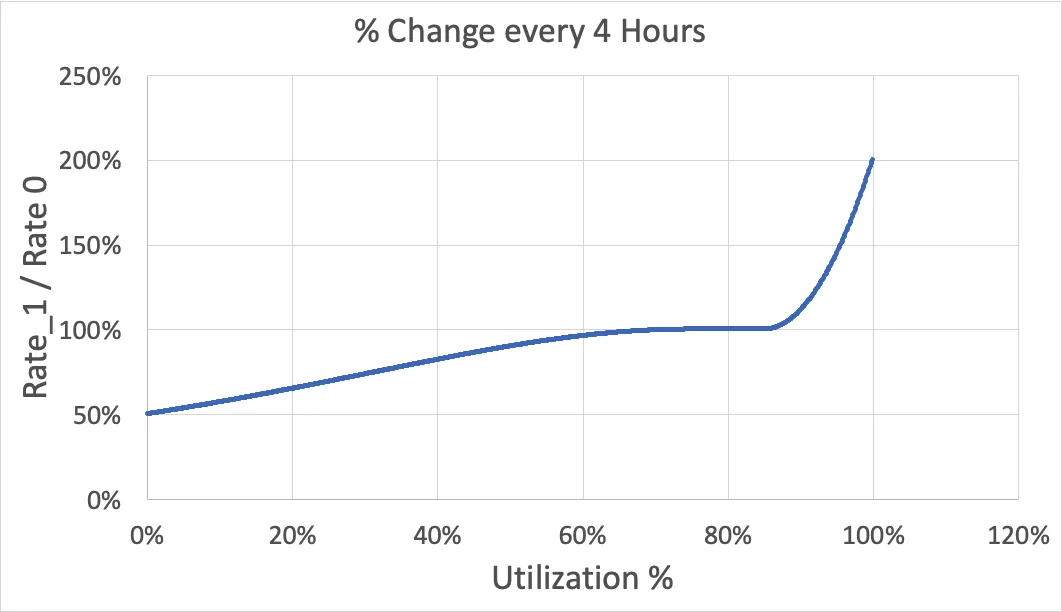
The Floating Rate V2 combines the concepts of linear rates and time-weighted floating rates. Specifically, it uses a linear function of the linear rate to determine the current rate, but adjusts the peak and maximum rate using the formula for time-weighted floating rates. Its characteristic is that the rate will immediately respond to changes in utilization on the linear rate curve, while adapting to long-term market conditions by adjusting the slope of the linear rate curve.
Like a time-weighted floating interest rate, Floating Rate V2 adopts half-life and target utilization range parameters. When the utilization rate is low, both the apex and maximum interest rates will decrease. Conversely, if the utilization rate is high, the apex and maximum interest rates will increase.
The reduction or increase in interest rates is determined by the utilization rate and the half-life. If the utilization rate is 0%, then the peak interest rate and the maximum interest rate will decrease by 50% for each half-life. If the utilization rate is 100%, then for each half-life, there will be a 100% increase.
Floating Interest Rate V2
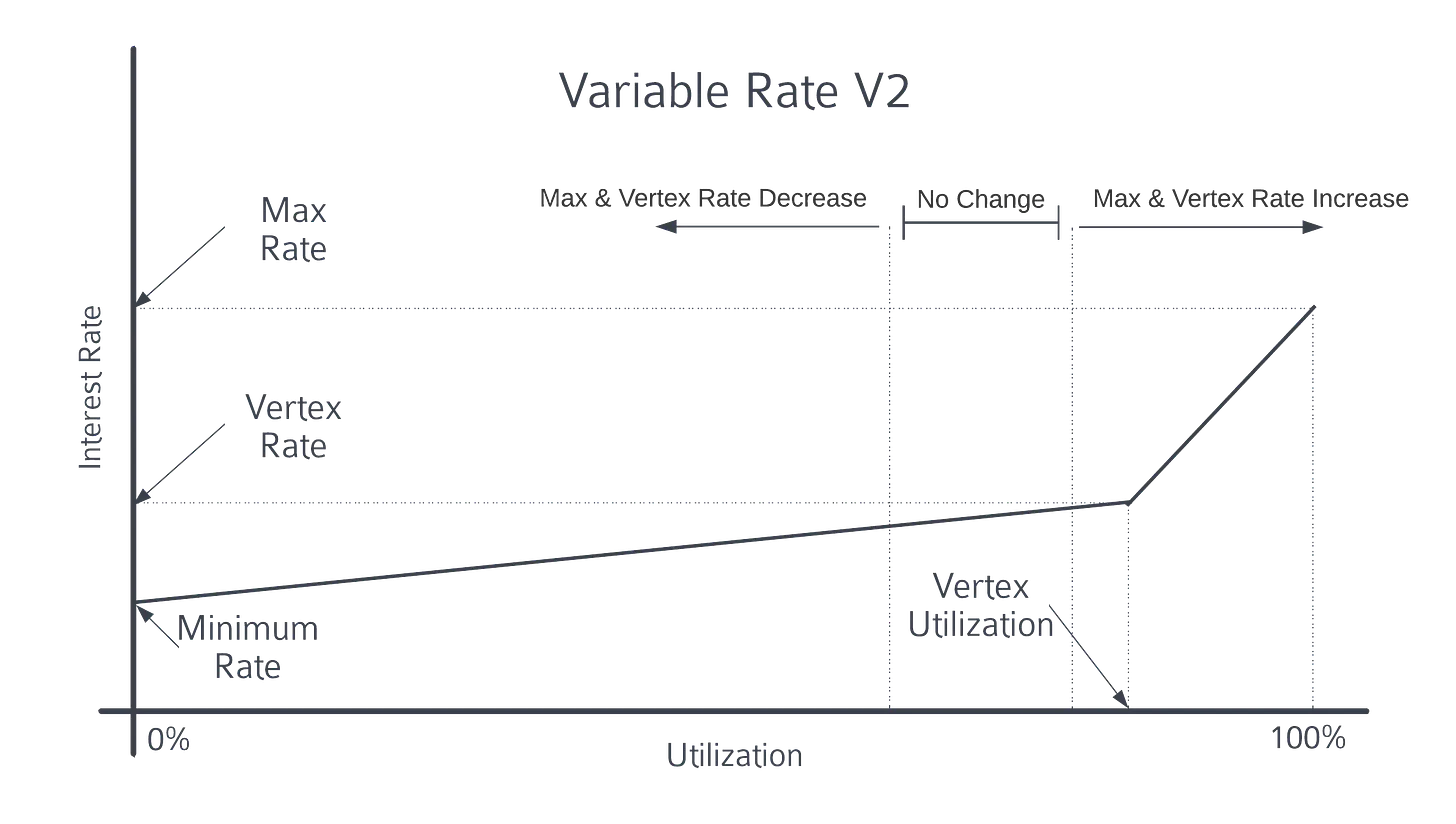
2/ Key Features of the Fraxlend Mechanism - Dynamic Debt Restructuring
In typical lending markets, once the Loan-to-Value (LTV) ratio exceeds the maximum LTV (usually 75%), liquidators can close out the borrower's position. However, in situations of severe volatility, liquidators may not be able to liquidate unhealthy positions before the LTV exceeds 100%. In such cases, bad debt occurs, and the last ones to withdraw their funds will bear the greatest losses, turning it into a "race to the bottom" game.
In Fraxlend, when bad debts occur, the pool immediately 'socializes' the losses, distributing them among all lenders. This helps maintain market liquidity, ensuring that the liquidity of the lending market does not dry up immediately after bad debts arise.
3/ Fraxlend AMO
The Fraxlend AMO allows for $FRAX to be minted into the Fraxlend lending market, enabling anyone to borrow $FRAX by paying interest rather than through the basic minting mechanism.
$FRAX cast into the money market will not enter circulation unless the borrower over-collateralizes through the money market, thus this AMO does not reduce the direct collateralization ratio (CR). It benefits the expansion of $FRAX's scale and creates a new pathway for $FRAX to enter circulation.
Strategy:
Decollateralize - Minting $FRAX into the currency market. The minted $FRAX does not directly reduce the Collateral Ratio (CR) because all borrowed $FRAX is over-collateralized.
Recollateralize - Withdraw minted $FRAX from the lending market.
Agreement Income - Costs incurred by the borrower.
Additionally, the Fraxlend AMO, with its ability to "print" and "destroy" money, can lower interest rates by minting more $FRAX or raise them by destroying FRAX. This rate adjustment capability is a powerful economic lever, as it alters the cost for all lenders borrowing FRAX.
Theoretically, if $Frax is willing and confident in its direction, it could mint enough $FRAX stablecoins to invest in Fraxlend, enticing users to lend $FRAX at interest rates lower than any other stablecoin on the market to scale up. This would create the most favorable lending rates, while also allowing for rate adjustments through the Fraxlend AMO in response to market needs. In contrast, stablecoin projects often struggle to control their lending rates.
✹ Fraxswap
Fraxswap utilizes a Time-Weighted Average Market Maker (TWAMM) to facilitate large transactions over extended periods without the need for trust. It operates entirely permissionlessly, with its core AMM built on Uniswap V2. TWAMM is discussed in detail in another article:
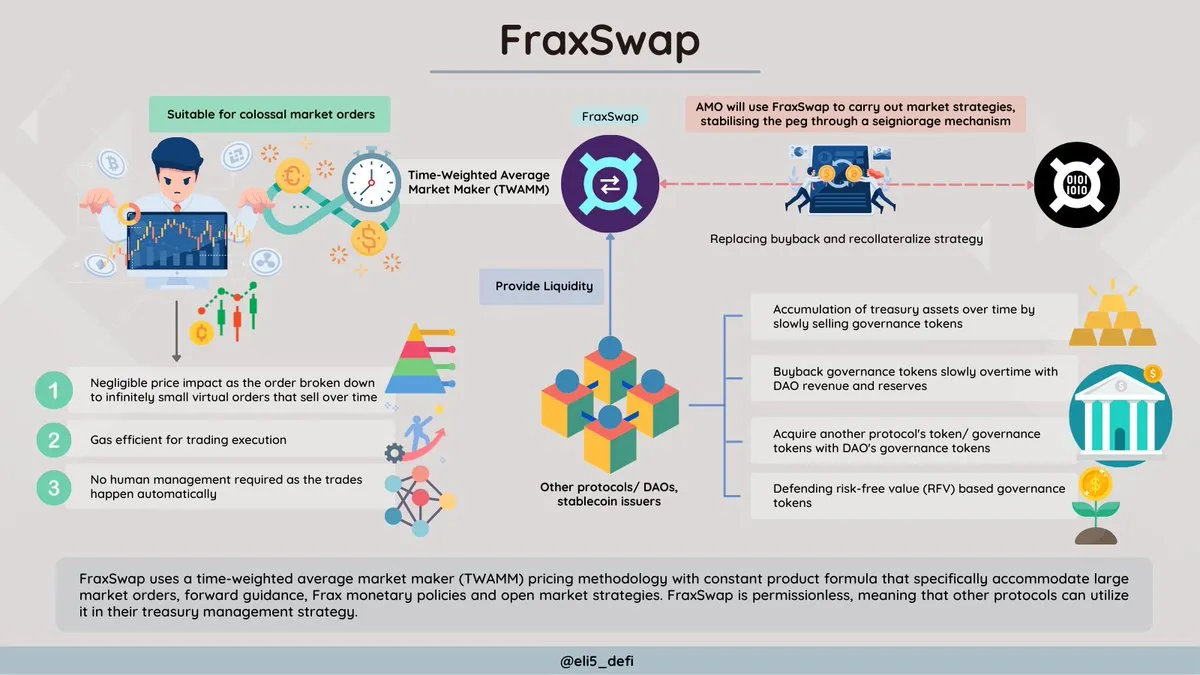
✹ FPI ($Frax Price Index) 1/ Definition
FPI is the first anti-inflation stablecoin, pegged to the real-world consumer basket as defined by the average U.S. CPI-U. The FPI stablecoin aims to maintain its purchasing power by keeping its price constant with all items in the CPI basket through an on-chain stabilization mechanism. Similar to the $FRAX stablecoin, all FPI assets and market operations are conducted on-chain and utilize AMO contracts.
FPI utilizes the unadjusted 12-month inflation rate from the U.S. Federal Government's CPI-U report: A specialized Chainlink oracle submits this data on-chain immediately after it is publicly released. The inflation rate reported by the oracle is then applied to the redemption exchange price of the FPI stablecoin. This redemption price increases (or decreases in the rare case of deflation) every second on-chain.
2/ FPIS
FPIS is the governance token of the system, and it also has the right to receive seigniorage from the protocol. Excess profits will be distributed directly to FPIS holders from the treasury, similar to the FXS structure.
When the revenue generated by FPI is insufficient to sustain the increase in FPI support due to inflation, new FPIS may be minted and sold to enhance the financial backing of FPI.
3/ FPI Stability Mechanism
FPI uses the same type of AMO as the $FRAX stablecoin, but its model always maintains a 100% collateral ratio (CR). This means that to keep the collateral ratio at 100%, the protocol's balance sheet must grow at least at the rate of CPI inflation. Therefore, the AMO strategy contract must earn a return proportional to the CPI, otherwise, the CR will drop below 100%. During periods when AMO earnings are below the CPI rate, a TWAMM AMO will sell FPIS tokens in exchange for $FRAX stablecoins to ensure the CR always remains at 100%. When the CR returns to 100%, the FPIS TWAMM will be removed.
✹ frxETH - Ethereum Staking Derivative Currently, $Frax ETH ranks 4th in the LSD market, with a TVL of $427.64M and a market share of 2.42%. However, in terms of yield provided, it leads the pack with a rate of 3.88% as of the time of writing. The reason $Frax ETH can offer higher than average returns is due to its control over on-chain liquidity governance resources.
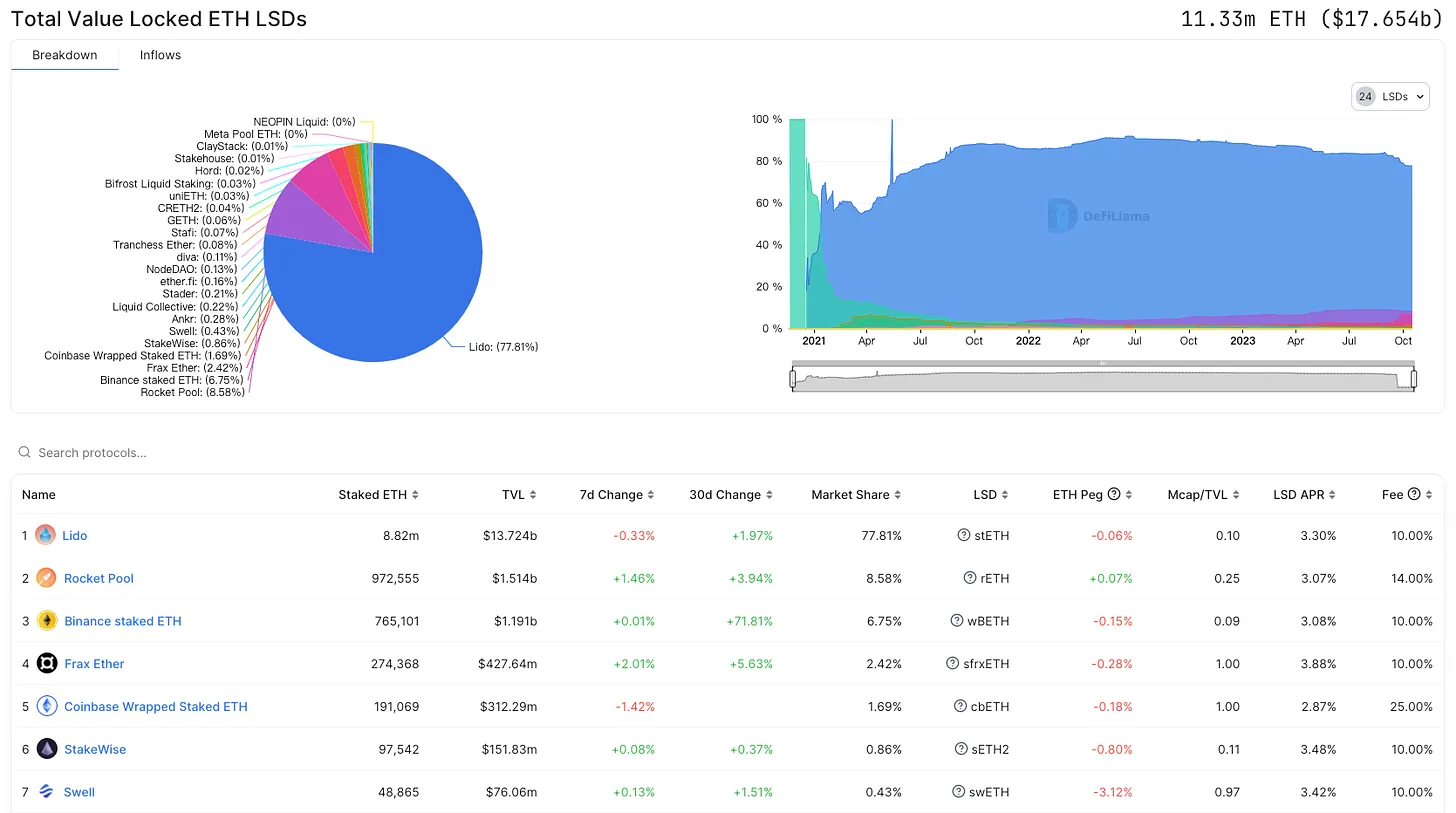
$Frax ETH includes:
**frxETH ($Frax Ether)** is an Ethereum stablecoin pegged to ETH, where 1 frxETH always represents 1 ETH, similar to Lido's stETH. However, holding frxETH alone does not result in rebase, nor does it yield Ethereum staking rewards.
**sfrxETH (Staked $Frax Ether)** sfrxETH is an ERC-4626 vault designed to accumulate staking rewards from $Frax ETH validators. At any time, frxETH can be exchanged for sfrxETH by depositing into the sfrxETH vault, allowing users to earn staking rewards on their frxETH. As time progresses and validators accumulate staking rewards, an equivalent amount of frxETH is minted and added to the vault, enabling users to exchange their sfrxETH for more frxETH than they initially deposited. Theoretically, as time goes on, the exchange rate of sfrxETH to frxETH will always increase, allowing users to claim a percentage of the increasingly abundant frxETH in the vault. This concept is similar to the principle of aDAI on Aave.
So, how does $Frax ETH manage to elevate its interest rates above the market average?
$Frax has accumulated a significant amount of $CRV and $CVX governance resources in the market through AMO and has established the frxETH Pool in Curve and Convex. This allows frxETH to gain incentives in third-party liquidity markets without issuing its own token, FXS. Consequently, all staking rewards from Ethereum are fully applied to sfrxETH.
Let's assume that out of the 270,000 ETH staked in $Frax ETH, 100,000 ETH are not staked to sfrxETH but are part of liquidity pools with other Ethereum assets like WETH, stETH, etc., while the remaining 170,000 ETH are staked to sfrxETH. The incentives obtained in each case would be:
100,000 Curve, Convex, and other liquidity pools containing frxETH receive $CRV, $CVX incentives.
17万枚frxETH staked as sfrxETH, earning a staking reward of 27万枚 Ethereum.
Thus, $Frax ETH leverages its on-chain liquidity governance resources to introduce external incentives for frxETH, enhancing its overall yield and indirectly increasing the market interest rate for LSD (sfrxETH).
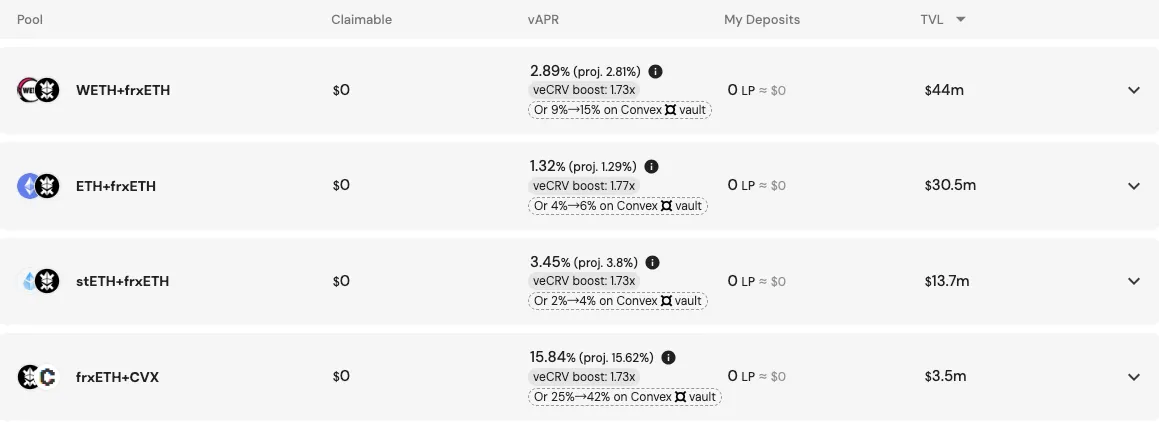
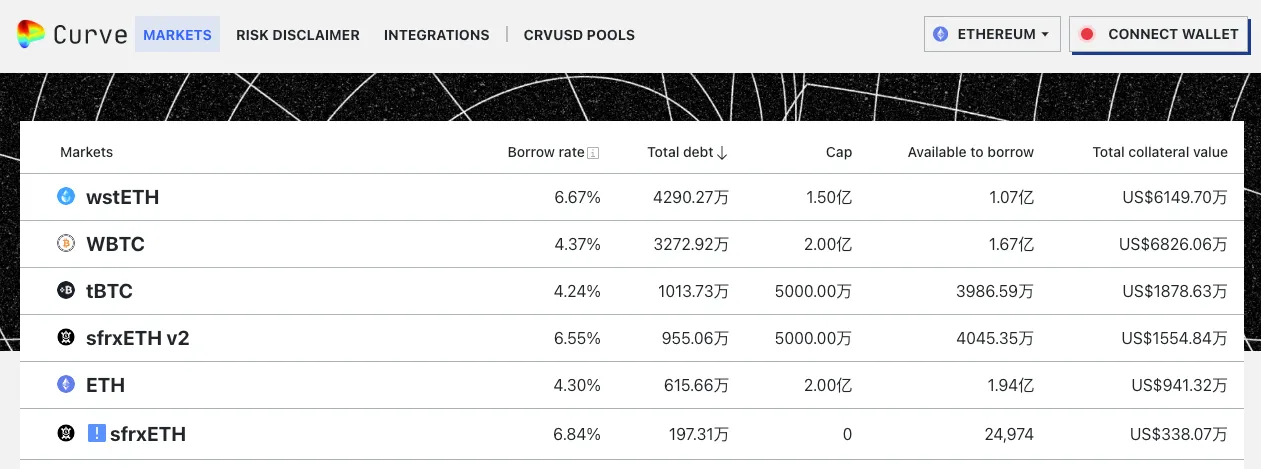
Token Economy Analysis
This section analyzes the financing situation of $Frax Finance's governance token FXS, token distribution, and the mechanisms related to veToken tokenomics.
Financing Situation
$Frax Finance has conducted two rounds of financing, which took place in July and August 2021, respectively. The financing token accounted for 12% of the total volume, but the financing amount and valuation were not disclosed.
Participating in $Frax Finance's investment are well-known investment institutions such as Parafi, Dragonfly, Mechanism, Galaxy Digital, as well as renowned founders from the DeFi sector like Aave's Stani Kulechov, Compound's Robert Leshner, Synthetix's Kain Warwick, Bancor's Eyal Herzog, among others. There are also investments from those with a CEX background, including Crypto.com and Balaji Srinivasan (former Coinbase CTO and A16Z partner), and more.
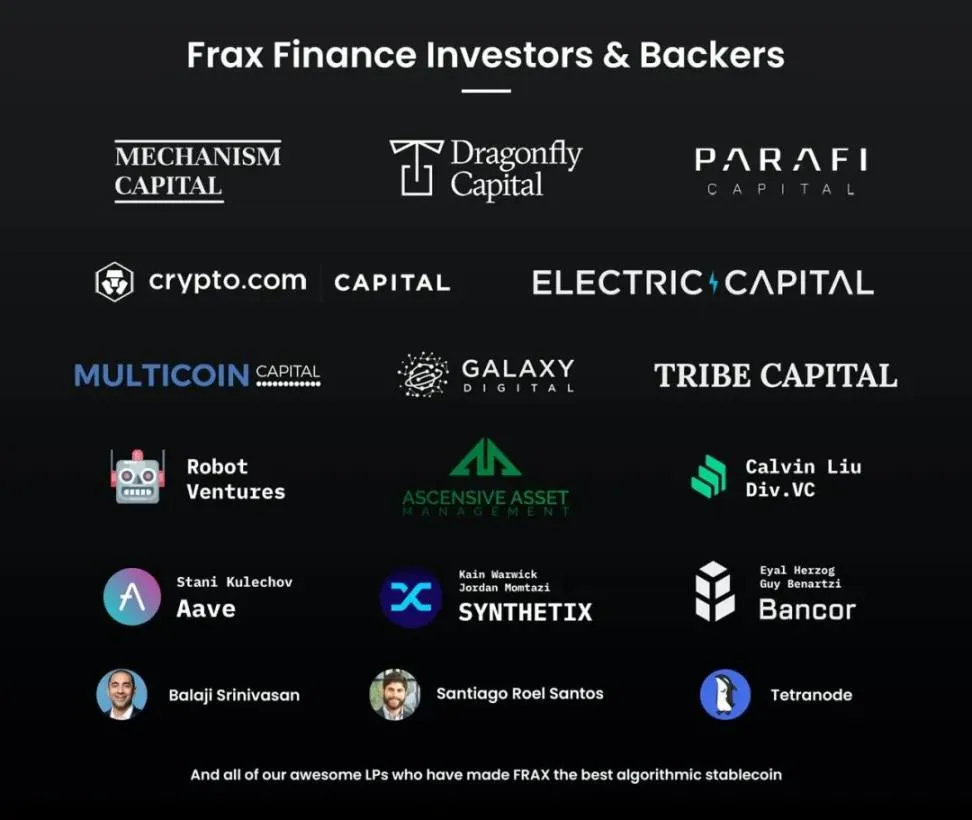
The governance token FXS ($Frax Shares) allocation is 60% – for liquidity programs, farming, and community – with a natural halving through governance every 12 months.
5% – Project Treasury/Grants/Partnerships/Bug Bounty – Decided by the team and community autonomously
20% - Team/Founders/Early Project Members - 12 months, 6 months lock-up
3% – Strategic Advisor/External Early Contributor – 36 months
12% - Accredited private investors - 2% unlocked at startup, 5% vested within the first 6 months, 5% vested within 1 year, with a 6-month lock-up period.
Currently, the total circulating supply of FXS is 74.57M, with a total supply of 100M. The team, advisors, and external investors have fully unlocked their shares, and the non-circulating portion is entirely allocated to the community (liquidity plans / treasury).
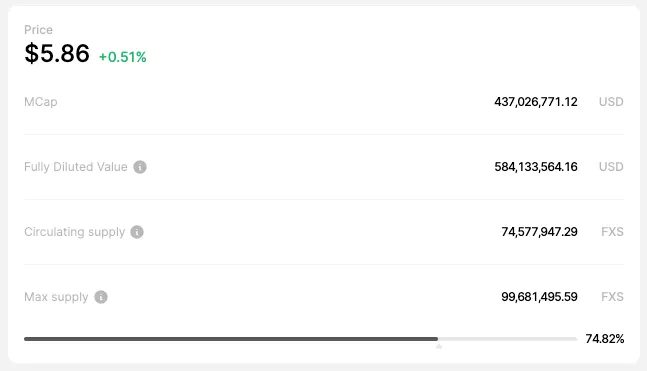
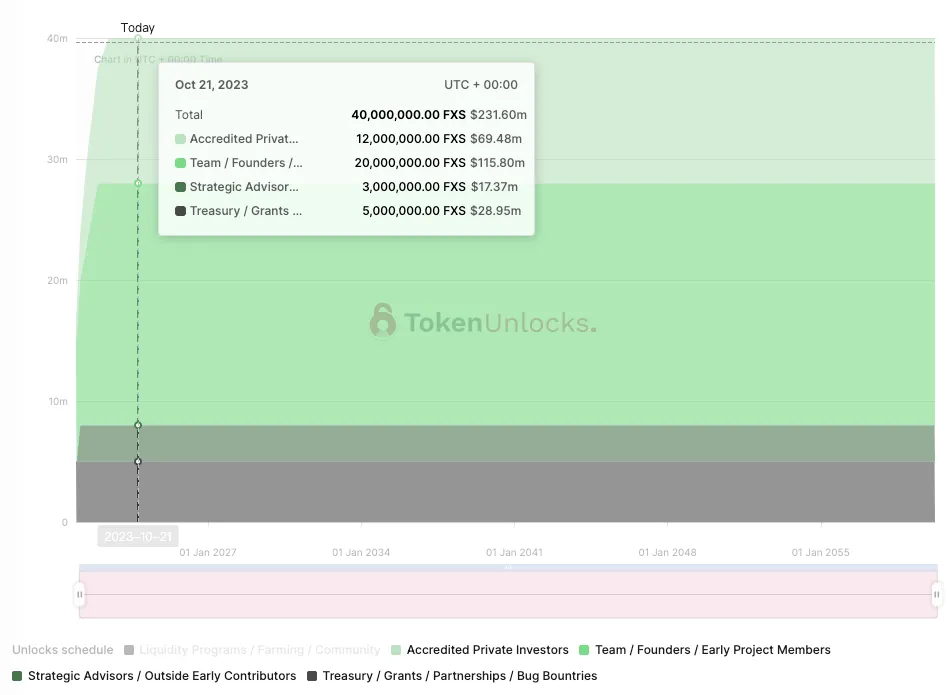
veFXS Token Economics
1/ veToken Model
This is an ownership and earnings system based on the Curve veCRV mechanism. Users can lock their FXS for up to 4 years to obtain veFXS. veFXS is not a transferable token and is not traded on the liquid market.
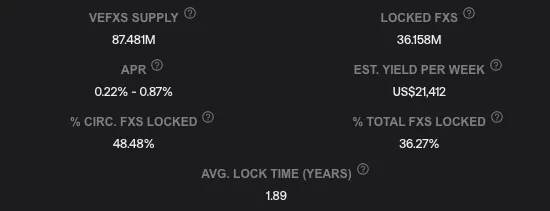
As the token approaches its lock-up expiration, the veFXS balance decreases linearly, nearing a 1:1 ratio of veFXS to FXS when the remaining lock-up time reaches zero. This encourages long-term staking and an active community.
Each veFXS has one vote in governance proposals. Staking 1 FXS for the maximum duration (4 years) will generate 4 veFXS. This veFXS balance itself will gradually decay to 1 veFXS over 4 years, at which point users can exchange their veFXS back for FXS.
2/ Gauge
Similar to the power of veCRV in the Curve system, veFXS can determine the emission incentives of the liquidity pools supported by $Frax through voting.
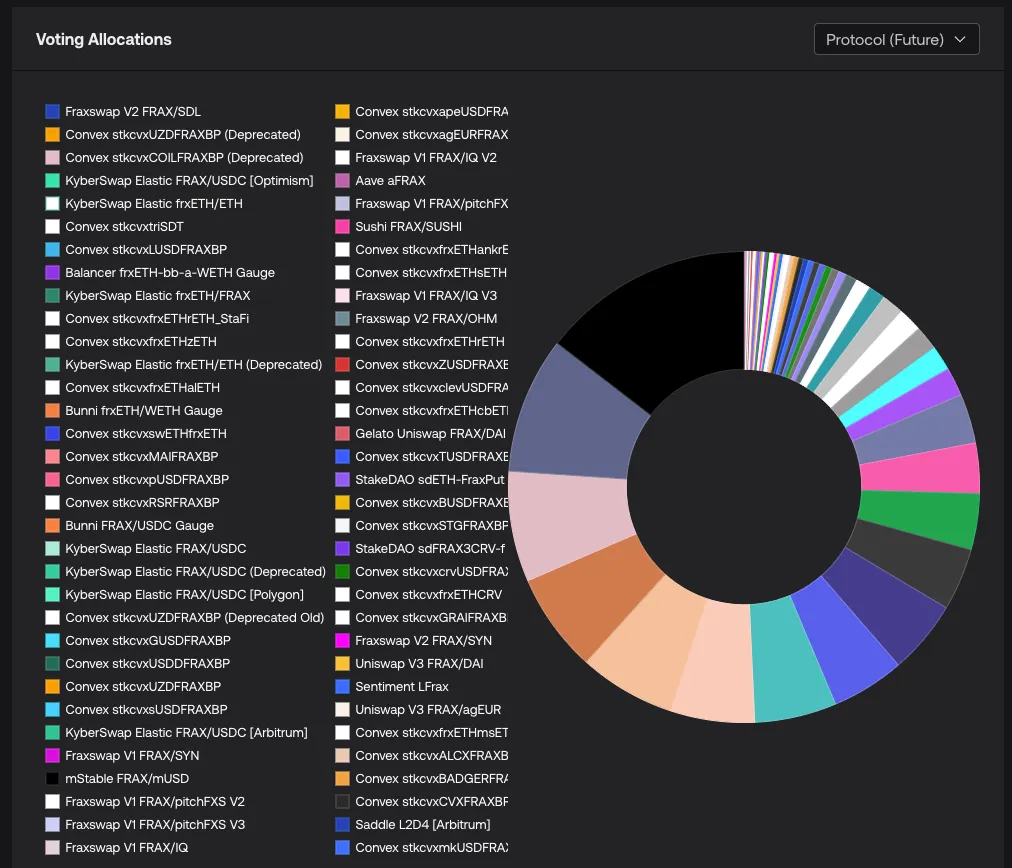
3/ Buyback
The primary cash flow distribution mechanism of the $Frax protocol is directed towards veFXS holders. The cash flow earned from AMO, Fraxlend loans, and Fraxswap fees is typically used to repurchase FXS from the market, which is then distributed as earnings to veFXS stakers.
However, with strategic adjustments in $Frax v2 and v3, the protocol will prioritize increasing the Collateral Ratio (CR) to 100%. Therefore, buybacks may be paused or limited. Once the CR reaches 100%, veFXS will have the opportunity to capture all of the protocol's revenue.
Data Analysis
This section provides an analysis and summary of the current treasury data, balance sheet, and true collateralization ratio of $Frax Finance.
Analysis of the True Mortgage Rate
We have reorganized $Frax's balance sheet as of October 10, 2023. The total assets held by the protocol amount to $616.8M, which includes:
The total amount of $FRAX held under the agreement is 450.1M
The total of US dollars and other assets amounts to $166.7M
Additionally, in Fraxlend, 65.6M $FRAX has been lent out (over-collateralized). The total circulating supply of $FRAX is 741.4M, with a collateralization ratio of 92.05%.
CR= Asset SUM / total $FRAX
If $FRAX held under agreement is removed from both the asset and liability sides, the collateralization ratio will decrease, but the absolute value of the collateralization gap will not change significantly. Currently, this absolute value is approximately 58.97M.
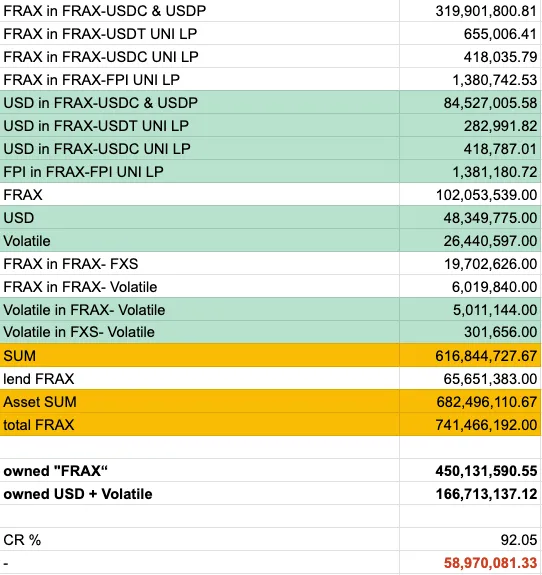
From this, we can see:
$Frax, through its AMO strategy, leveraged $166.7M of underlying assets to multiply the scale of stablecoins without breaking the peg. (If issued at a traditional 1:1 ratio, the circulation of $FRAX would be equal to the value of the underlying assets, $166.7M)
To achieve a CR of 100%, the protocol needs to earn 58.9M in revenue to enter the treasury.
In March 2024, the Collateralization Ratio (CR) of the $FRAX stablecoin reached 100%, a milestone achieved within 5-6 months since the first article was published. This increase stems from revenues generated through AMO, RWA, LSD, and other operations. However, a significant factor contributing to this achievement is the bull market, which led to over 100% price increases in assets held by $Frax, such as $CRV, $CVX, and FXS.
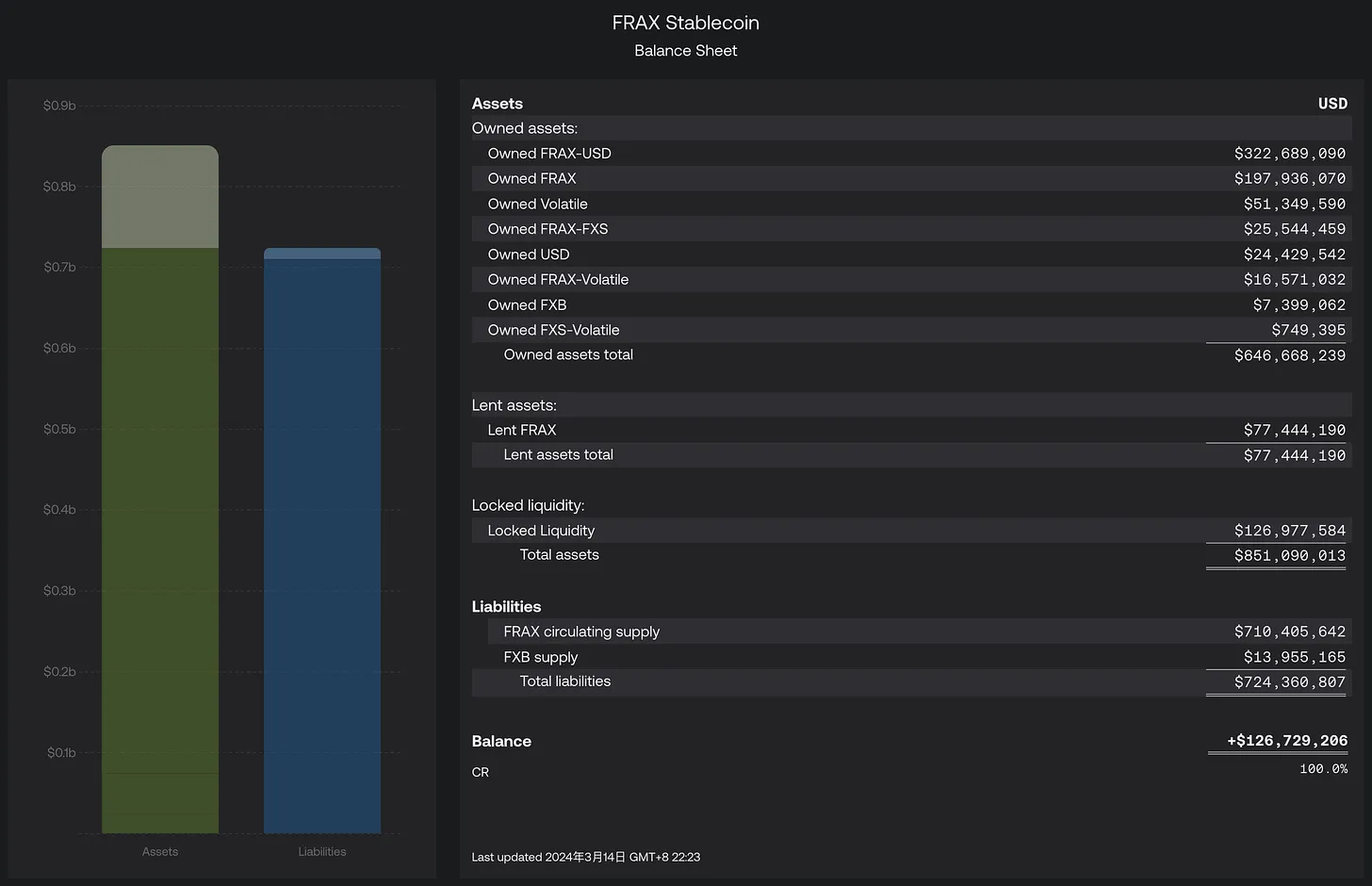
Following this, Sam, the founder of $Frax, mentioned in an interview that there are plans to reactivate the dividend switch for veFXS, which would significantly enhance the potential value of the FXS token.
Investment Perspective Summary
Overall, we began writing articles in October 2023, when the Collateralization Ratio (CR) was around 92%. At that time, due to the ongoing bear market, excluding the rise in floating assets held by $Frax, we estimated that it would take at least a year to increase the CR to 100%. However, with the arrival of the bull market, $Frax achieved this goal six months ahead of schedule. Nevertheless, the floating assets in its collateral, mainly on-chain governance assets (such as $CRV, $CVX), will still constitute a fluctuating factor in $Frax's CR. Therefore, strictly speaking, $Frax remains a hybrid partially collateralized stablecoin.
If we're talking about business potential, RWA business growth supports protocol liquidity in bear markets, while AMO can play its biggest role in bull markets. L2 is the key factor in raising the overall project valuation ceiling for Frax.
From an investment perspective, we should pay attention to the following indicators:
The financial utilization and profitability of all AMOs
Prices of $CRV and $CVX tokens
Growth of RWA Business
L2 Ecosystem Construction Status
$Frax has built a sufficiently large full-stack stablecoin system. It's evident that both Fraxswap and Fraxlend, aside from being launched on the public market, are serving the $Frax Finance ecosystem itself. This aspect is akin to the subDAOs in the MakerDAO endgame plan.
A commonality between MakerDAO and $Frax is that both are planning to horizontally expand around their core (stablecoin) to build a full-stack product.
The difference is that MakerDAO has decided to outsource these functions to other subDAOs, while $Frax is governed uniformly by frxGov.
$Frax has managed to capture almost all the right demands in the DeFi market, and its mechanism design is currently forward-looking. However, the apparent issue is that a vast system encompassing stablecoins, trading systems, lending systems, cross-chain systems, LSD, and Layer2 requires a highly efficient and robust governance module. Moreover, the risk isolation between functions is particularly crucial, testing the stability of future protocol functions and on-chain governance.
Risk Warning
The cryptocurrency market carries extremely high risks and does not constitute investment advice. This article represents an independent viewpoint without any sponsorship.
Welcome to followcmdefi.io👏
Crypto Research
Crypto Alpha Aggregation
DeFi strategies, insights, and trends
Metaverse
NFT
🐦My Twitter twitter.com/cmdefi
🏠 Community: https://discord.gg/49DYznEdu4

